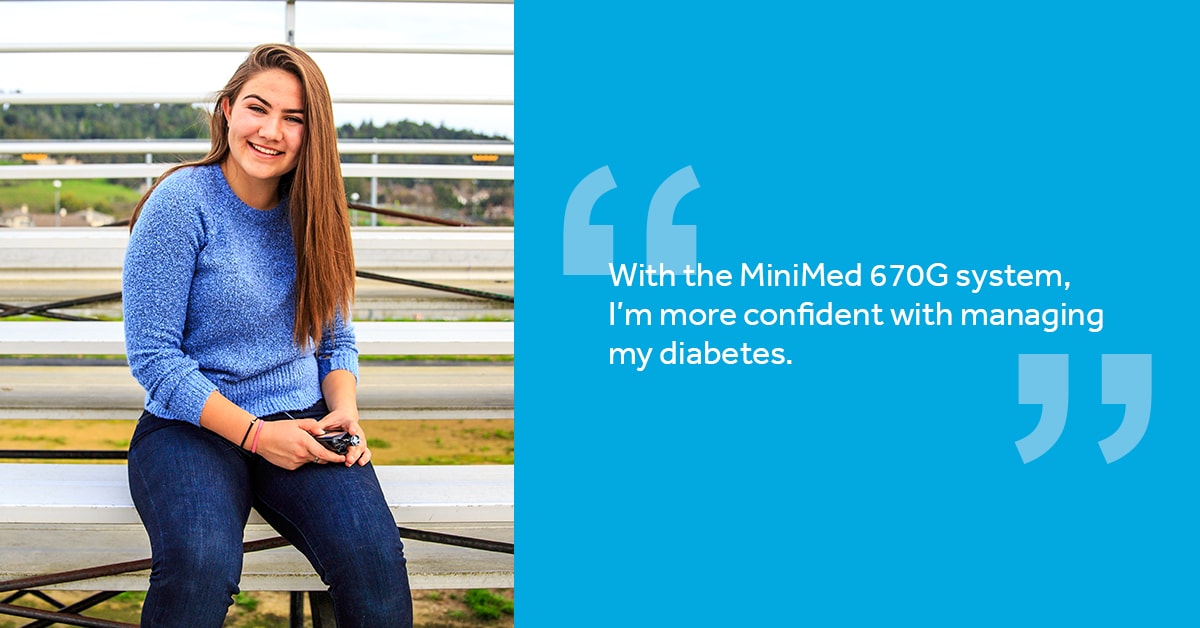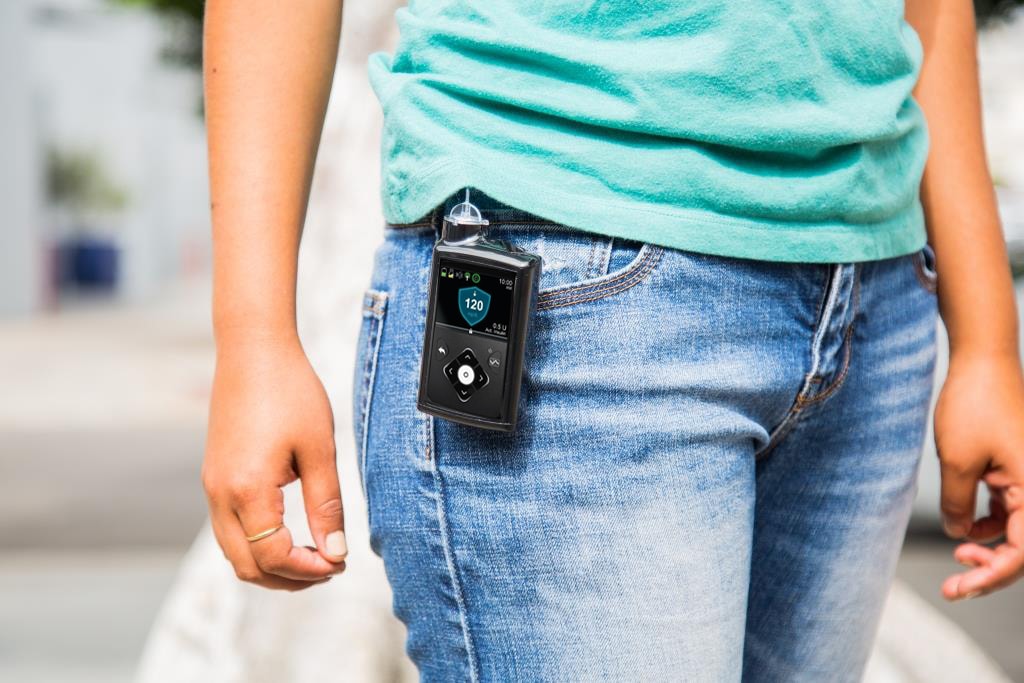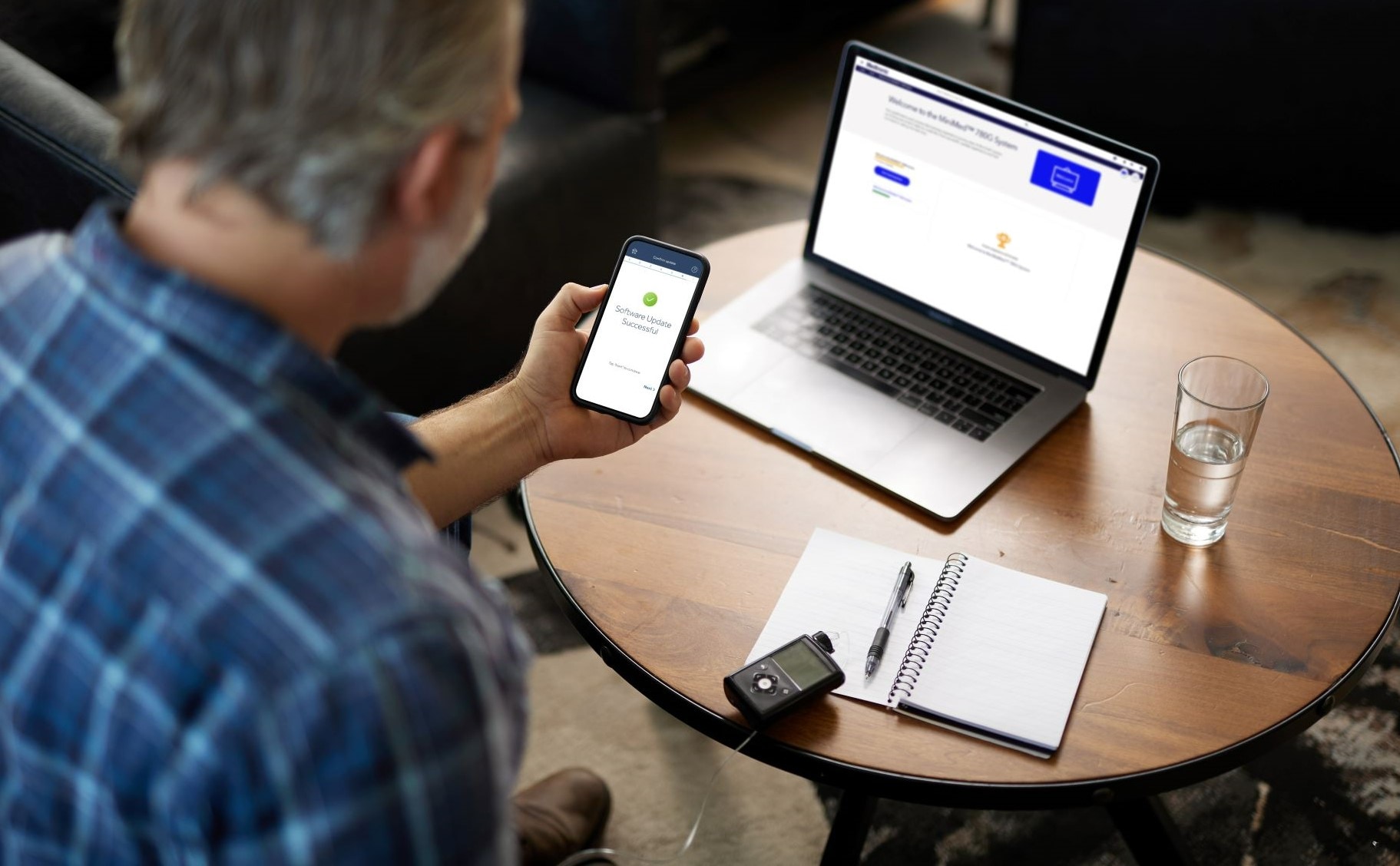Nicky answers your questions about the MiniMed™ 670G system

Meet our MiniMedTM 670G system video star, Nicky Williams. We think she’s pretty amazing.
I’ve met a lot of inspiring people with diabetes. But when I was lucky enough to meet Nicky, this 17-year-old who plays soccer, hikes mountains, rides horses, excels in school and is a working through an ambitious “1000 places to see” list, I was wowed. Talk about someone not letting diabetes hold her back.
She’s also been using the MiniMedTM 670G system for more than a year as a clinical trial participant and kindly volunteered to let us share her story in photos, video and more. We know you’re all curious to hear what the new system is like in the real world, so we recently asked our social community what you’d like to ask Nicky. Today, she’s answering your questions!

What's your favorite part of the new system and does the system work well with your daily life?
Diabetes is hard for anyone, but as a busy teenager who just wants to go have fun with friends it can be extremely hard to take care of both. However because my MiniMedTM 670G system is capable of helping me take care of diabetes, it allows me to focus on being a teenager rather than a diabetic.
My favorite part of the system is how confident the pump, especially the Auto Mode feature, makes me in my diabetes. It takes care of most of my blood sugar fluctuations without me having to even think about it. And I know that if anything even starts to go wrong with my sensor glucose then it will notify me so that I will have plenty of time to deal with it. Because of this it has definitely become an essential part of my busy life. I have tried to go a few days without the system, and have noticed that I am much more anxious throughout the day because I do not have that extra help from the system and have noticed that my blood sugars are much worse on those days.
 How does the pump operate during a sensor warm up, and how does the system work if something goes wrong with your sensor? Is there a default operating system is place for these times?
How does the pump operate during a sensor warm up, and how does the system work if something goes wrong with your sensor? Is there a default operating system is place for these times?
For me it generally takes a few hours to do the entire process of charging my transmitter and putting on a new sensor so that it can warm up. Because of this, I am generally not in Auto Mode and I am running on the default operating system (Manual Mode) for most of the warm up. The default operating system for the MiniMedTM 670G system is the normal operating systems of most pumps with just the use of constant basal and regular boluses. It is always available and is what the pump reverts to when it is not in the hybrid closed-loop. During this time, as long as all my settings are still accurate, then everything operates well for me.
About the bad sensor, it is not common that I get a bad sensor as long as I wear the tape, which is generally pretty strong. However the few times that I have messed up the sensor’s tape tab the MiniMedTM 670G system stopped getting information from the sensor. I knew something was wrong with it and have been able to quickly address the issue. Editor’s Note: In Manual Mode, you can use the system as an integrated pump and sensor like Nicky does, with Suspend on low or with Suspend before low.
Is the new sensor truly accurate? When it is in Auto Mode is it truly auto for basal or does it tell you to go stick your finger then it makes changes?
I have found the sensor to be extremely accurate and is generally within about 20% of my actual blood sugar (I think last time I compared the sensor glucose to my tested bg it was like 6 mg/dL off!). I would say the only time it is kind of far off is when my blood sugar is radically changing so the sensor isn’t able to keep up with it, but it is still only about 30 mg/dL off. Also, when you are in Auto Mode it will take care of small highs or lows but it is not capable of taking care of quick or large changes in my sensor glucose levels, like ones above 200 mg/dL.
Because of this, it is recommended I test by fingerstick and correct when my numbers are high or treat if low. The pump may move you out of Auto Mode and back into the normal basal mode if the sensor doesn’t feel like it is accurate. To get back into Auto Mode I have to prick my finger and calibrate with that blood sugar and possibly follow some other instructions depending on what the pump wants. The system must be calibrated with a blood sugar check every 12 hours or else it will transfer me out of Auto Mode.
Does the 120 mg/dL target make you high? I feel like it should be lower.
The 120 mg/dL target generally works for me; however I have always had the 120 mg/dL target so I personally do not know if a different one would be better or worse. I have however found that there are many other settings I can change if I am running high which can help bring my glucose levels down. For example, if I am running high in the morning then I might change my morning Insulin to Carb ratio to be more aggressive to help keep my blood sugar lower.
Have you been able to sleep better on the system? My teenage son sleeps through the alarms of his current pump!
My numbers have definitely been better and more even throughout the night. I generally coast around the 100-150 range while in Auto Mode on the MiniMedTM 670G system. The pump is able to take care of most of the rises and dips of my diabetes overnight without me having to do anything. However while it does take care of many of the fluctuations it will generally try to wake me up if I am too far out of range, in which case it changes out of Auto Mode and into just the normal basal rate. To go along with this I also sleep through most of the alarms, unless I am either really low or really high, in which case my body generally naturally wakes me up. Overall though, I found that if I am not woken by any alarms, it definitely helps me to get a better night’s sleep and feel more rested in the morning. 
Side note: The alarms are loud, even on vibrate, so if you are sleeping over with a friend you might want to warn them just in case it wakes them up.
How does a system like this manage high carb meals, like a bowl of spaghetti?
In my experience, if I pre-bolus for big carb meals then it handles the meal pretty well and my numbers stay relatively flat. However, if I post-meal bolus, which is what I usually do because I am not good at pre-bolusing, then I generally end up spiking up into the high 200’s for about 2 hours until the insulin is able to catch up. Once the insulin catches up the pump is able bring me back to a good blood sugar range and keep me there even if there are any little post meal fluctuations like a small low.
How do you handle exercise while in Auto Mode?
 In activities that I am able to keep my pump on for, like jogs, riding my horse, and hiking, I have found the temp target to be extremely helpful. (The
In activities that I am able to keep my pump on for, like jogs, riding my horse, and hiking, I have found the temp target to be extremely helpful. (The  Temp Target allows me to change the 120 mg/dL target to 150 mg/dL for a few hours). I didn’t use the Temp Target for about the first 6 months of using the pump, but since I discovered it, I have fallen in love with it! I can’t even count the amount of times it has helped my number stay at 150 mg/dL when I know that without it I would have gone low. However, there are still times when my blood sugar has dropped during exercise. In many of those cases I have been able to start treating the low before it got serious because I was able to watch the arrows on the screen and see which direction my glucose was going.
Temp Target allows me to change the 120 mg/dL target to 150 mg/dL for a few hours). I didn’t use the Temp Target for about the first 6 months of using the pump, but since I discovered it, I have fallen in love with it! I can’t even count the amount of times it has helped my number stay at 150 mg/dL when I know that without it I would have gone low. However, there are still times when my blood sugar has dropped during exercise. In many of those cases I have been able to start treating the low before it got serious because I was able to watch the arrows on the screen and see which direction my glucose was going.
I started the MiniMedTM 630G three weeks ago and slated to migrate to the MiniMedTM 670G in the next few months. My sugars run high when I travel. Has the MiniMedTM 670G simplified your adjustments when traveling?
I have found that I too run high when I travel and have definitely noticed that the Auto Mode feature helps to make compensating for that easier. It takes care of the most of the general highs for me throughout the day and keeps me more vigilant on them. It’s able to get my numbers down to the 120 mg/dL range overnight and keeps them there throughout the night. However, I also generally need to be a little more generous with my bolusing for the first few days. I think, though that the majority of that issue stems from my diet being more carb heavy while I am traveling.
Editor’s note: want to hear more? Listen to our Facebook Live with Nicky here.




Blog comments
When in auto mode, is there an option to turn on/off suspend before low or does it do it automatically? I saw in my setting review it says suspend on low is turned off... does that mean if I fall into manual mode, it is turned off?
Rebecca, when in Auto Mode you will not be able to use Suspend on low. The system will adjust your basal insulin delivery to try and keep you as close to the 120 mg/dL target as possible. If you go into Manual Mode, you will need to restart your SmartGuard features (turn them on if they've already been previously set-up). Remember that there are several alerts that can be set up, such as a low alert, and there is a default alert at 50 mg/dL.
Karrie, Are you saying that when you go into manual mode you can turn on smart guard features? Or were you just saying its important to remember to put it back into auto when you are finished with the manual mode?
Dave, the SmartGuard technology can be used in both Manual and Auto Mode.
When auto mode is in warm-up, is the time necessary for the warm-up extended when the pump goes into suspend mode? Or when I manually return the pump to auto mode (warm up) does the warm-up time start over?
Great question, Tim. Depending on the case, the system will likely prompt you for a new BG reading and should resume within 10-12 minutes.
Just to fulfill my curiosity, what is actually happening when the pump states "Do not calibrate, sensor updating"?
Hi Tim. When your insulin pump states this, it's due to a temporary situation that the sensor is trying to adjust for. The new CGM, incorporates diagnostic technology that continuously monitors the sensor.
Ok Great! Thanks for responding so quickly.
You're very welcome!
So is it still in Auto mode during that time or back in manual basal mode?
What kind of things make it need to do that?
Patrick, You can stay in Auto Mode for up to 3 hours while the sensor makes adjustments. This can be caused by shifts in ISIG values or a sensor not properly inserted. If you have specific questions, please reach out to our 24-Hour HelpLine at 800.646.4633, option 1.
What am I supposed to do when it wants to "sensor updating" at 10pm at night and then it wants to calibrate 3 hours later? This is starting to be so frustrating for me. The helpline is no help because I seem to be on hold for so long and the automated system is like going through a maze. This is my first week on the 670g. I was on the 630 for 10 months but it caused me so much anxiety.
Luke, I’m sorry you are frustrated. Our 24-Hour HelpLine is best to discuss this with. If you send your contact information to dhelp@medtronic.com, I can have a teammate call you, to make things a little easier.
I am just getting started on my first insulin pump (670). Now this might sound silly but I keep reading about sensors that you need. I just went through my start up box with the rep, and I don't have any sensors. I know there was a mix up because I received 2 pump start up boxes. I am waiting on the return info for the second start up box. So I guess my question is am I supposed to have a separate sensor unit?
Hi Erin, apologies if this wasn't communicated to you when your insulin pump shipped. However, your sensors will ship out this fall once we get through those who are in our Priority Access program. It's important that we keep our commitment to that group and once complete we'll begin shipping sensors out to those who ordered the pump and haven't received the sensors.
I just went into Automode this week with the 670. In Automode, the pump has not asked to do a correction bolus regardless of the BG I enter. I have been struggling with ever changing Basal rate needs. I can't figure out how to correctly give myself a correction in auto mode. Any suggestions?
Chris, the MiniMed 670G system will ask for a correction bolus when needed. If you think you need to adjust your active insulin settings or carb ratio, please talk with your physician.
Why does the pump not accept the glucose reading I enter after testing. This usually happens when the is a large difference in actual BG and what the pump is getting from the sensor. If this happens twice the pump says to replace the sensor.
Hi Tim, have you had a chance to discuss this with our 24-Hour HelpLine? If not, I recommend calling them at 1.800.646.4633, option 1.
I have had diabetes since I was 18 years old I just turned 54 . And for the first time in my life I got a 630G which my A1C went from a solid 14 to a 6.7 in three months well I have not ever ever had a 6. nothing ever. And through my life I have lost my leg above the knee and Im legally blind SinseWell Medtronics promised me that I would get a 670G when they came out which they did and I assumed that my insurance would cover . I have the 670G with the transmitter for the Gaudian Link sensorsors. Well my insurance co. Unided Health Care I have . Well I have medicare and Medicaid. They paid for the pump but at first denied to pay for the Contour test strips and the sensors for the Gaurdinan Link. I appealed and appealed and finally got them to cover the test stips but now they are saying my insurance don’t cover the sensors . Ive already filed an appeal for the ALJ hearing finally Ill be abel to say something to the judge over the phone. I don’t know why they are making it hard for me to get every thing I need to make this pump work. Could you please send me a letter or something I can present to the judge that in detail tell about this being a closed loop system, an artificial pancreas. Please email me back with information I desperately need help???
Richard, I'll have a member of my team reach out to help.
I'm getting ready to make the transition from the 630g to the 670g. Can the settings from the old device be restored to the new 670g?
Hi David, this will be a manual process but your Medtronic trainer can help if you have any questions. If you upload to CareLink, you can pull a recent device report which has documentation of all of your settings. You can use this as a helpful guide when you're setting up your MiniMed 670G system.
Hi my son is using 670 g from last two months and from last week pump is asking for sensor change on daily basis any idea why is that for ?
Good question, Sabeen. I recommend connecting with our 24-Hour HelpLine team at 800-646-4633 then choose option #1. They should be able to answer your questions and get you the help you need.
Call Medtronic the direct extention for 670g problems is 22020.
Why does the 670g under estimate correction boluses (>3 times fewer units) in auto-mode compared to manual-mode?
Tim, for more information on how the target algorithm works please check out the following blog: https://www.medtronicdiabetes.com/loop-blog/10606-2/.
I have been using the 670G for a few months, and the micro boluses do not seem to take care of keeping my blood sugar between 120 and 150. Without eating or drinking any carbs, my BS will rise from 115 (for example) to 200. Why don't the micro boluses take care of this and keep my BS between 120 and 150?
Robyn, the goal of the MiniMed 670G system is to increase the time with glucose values in the target range of 70-180 mg/dL. To get there the mid-point target of 120 mg/dL is used by the target algorithm. For more information, check out the following blog: https://www.medtronicdiabetes.com/loop-blog/10606-2/.
Hi, I received my 670G about 5 weeks ago and I seem to be experiencing lost signal alerts more often than I would with my 630. I get a least 1-2 a week, and today I've lost the signal more than 4 times! I double tape my transmitter site so I don't think it's just a tape issue, and this is day 4 of the sensor (and while I had two lost signals on day 2 of this sensor, today has been unbearable!). I'd chalk it up to a bad sensor and change (and probably will anyway), but given it has happened with other sensors before, wondering if it's a transmitter issue or something else instead?
I’m very sorry that you are having trouble, Gina. This is a good conversation to have with our 24-Hour HelpLine, as they can go over troubleshooting with you and make sure everything is working as designed. Please give them a call at 800.646.4633, option 1.
What does "do not calibrate. Sensor updating..." mean?
Steve, this alert means that your sensor glucose value is unavailable temporarily. This alert can last up to 3 hours. If you have additional questions on your sensor, I suggest reaching out to the 24 HelpLine at 800.646.4633, option 1.
Hi
I have been very frustrated with the new 670G pump. I have gone to two training sessions so far and am scheduled for another one this Tuesday. When it says it is time to calibrate I do so and then it still says I need to add blood sugar amount to continue on auto mode. This also happens when I test and send results to the meter- it still says I need to enter blood sugar. That just doesn't make sense to me. Sometimes it does accept the reading but I would think thatit already knows the reading anyway.
Brenda
Brenda, I can certainly understand your frustration. In addition to your scheduled training, this is a good conversation to have with our 24-Hour HelpLine. They may be able to offer suggestions that can help with this. Please give them a call at your convenience at 800.646.4633, option 1.
I experienced the "sensor updating" alert for the first time last night. I couldn't find any information in the user guides but did find a little here. The alert started after I went to bed and didn't resolve itself so I spent the night being woken up that message being repeated over and over. I only got out of this by removing the transmitter, turning the sensor connection off, waiting 15 minutes and then reconnecting the transmitter and starting the reconnect sensor process. Not sure why this worked but it would have been nice to have this solution posted somewhere. I got it from another 670g user and to be honest, it has a sense of lets-give-this-a-try instead of a known solution. Is there anything wrong with this approach?
Thanks for checking in, Joe. The Guardian Sensor 3 has built in diagnostic technology that continuously monitors sensor health. The “Sensor Updating” alert means that your sensor is not currently reading your glucose values, as it is testing itself. This could last anywhere between 15 minutes to 3 hours. I do recommend speaking with our 24-Hour HelpLine at 800.646.46333, option 1, to discuss how you cleared the alert. They are our experts and can give you the best direction. In the meantime, I will share your feedback about adding this to the user guide with our team.
I frequently recieve this alert and have NEVER had a successful update...everytime it does this, within an hour or two, it tells me "sensor expired" or similar and that i need to insert a new sensor...sometime less than 24 hours after getting this sensor up and running...I have no idea what I'm doing wrong...the 24hr help desk has not been able to help either...any of the 6 times I've called them...
That's interesting, Danika and I'm sure very frustrating. I'd like to see if we can get you some answers. Send me your contact information to dhelp@medtronic.com and we'll see what we can do to help.
My son wears a pump and does not bolus hardly ever. His roommate has had to call the EMTs to revive him from low blood sugar several times. The last time his reading was 17. Would proper bolusing prevent this?
Marlyn, I am very sorry to hear this. This is a good conversation to have with your son’s healthcare provider, as it is specific to his carb intake, activity level and the instructions of his physician. They are best equipped to answer these type of questions, based on your son’s individual needs.
We are interested in the 670G pump for our 15 y/o daughter. If approved by insurance and all, what is the wait time looking like? We realize it's a closed loop system, but if she wants breaks from wearing the Guardian Sensor 3 is that doable with this pump? And what is the wait time for receiving the Guardian Sensor?
Hi Val. We are currently experiencing a rolling back order on our MiniMed 670G pumps, but they are generally shipping within 2 weeks of their eligible ship date and Guardian Sensor 3s within a week. Our Puerto Rico facility is back up to a 100%, and we are working around the clock to ship orders as quickly as possible.
While we believe you get the most out of our therapies by using the MiniMed 670G system with CGM, we do understand that’s not always an option. She will be able to wear the pump as a standalone device.
If you’re ready to take the next step, please contact your device specialist at 800.646.4633 option #3. They will be able to walk you through the process, including insurance coverage.
I was originally on the 630 and got the new 670 upgrade. It is absolutely horrible. How would I go about keeping my old pump and return ing this useless innacurate 670?
I am sorry to hear about your experience with the MiniMed 670G system, Justin. Our Customer Support Center would like to help with your concerns and can be reached at 800.646.4633 option #5.
While I am in auto mode my blood sugars are very high frequently. High, above 300, sometimes above 400. Before using the 670G I never had highs like this. My blood sugars were very good. Maybe it’s my settings. In the Manual it says”your high and low settings apply to auto mode”. How do these setting effect the insulin delivery in auto mode? Can you please explain these settings to me and how auto mode uses these settings?
Thank you, Theresa
Theresa, we are happy to help and I'm sorry you are having trouble. This is a good conversation to have with our 24-Hour HelpLine as they can go over your settings and answer any specific questions you have. You can reach our team at 800.646.4633, option 1.
I have tried to speak to them about it and they tell me this is something I should speak to my doctor about, which I will, next time I see her, But in the meantime, I would like to know what they have to say about the settings. Since this is their line of work, they would have more knowledge about it possibly and maybe my doctor.
Pagination
Post a new comment
Required fields are marked *